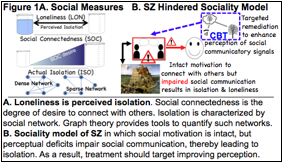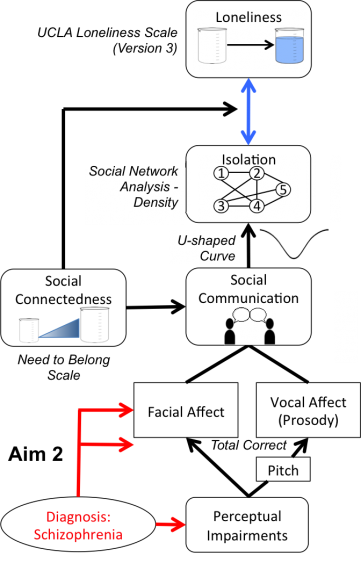 Basic Research Questions
Basic Research Questions1. Do individuals with schizophrenia have intact motivation to interact with others?
2. How does social communication relate to loneliness, desire for social connectedness, and actual isolation in both a healthy population and in schizophrenia?
3. How do these measures relate to clinical outcome?
Humans have evolved highly complex social cognitive and motivational structures that enable us to bond and communicate. Loneliness, desire for social connectedness, and actual isolation can measure these needs (Figure 1A). Individuals with schizophrenia have diminished social motivation that accompanies well-document deficits in communicating via facial, vocal, and bodily gesture. Our recent data support recent research that suggests more heterogeneity in loneliness and social connectedness in SZ. In both healthy individuals and individuals with schizophrenia, social connectedness was related to one’s sensitivity to decoding vocal emotion via intonation (prosody) and even more basic, but related, abilities in perceiving pitch. However, the nature and directionality of this relationship is enigmatic, as is more generally, the relationship between these traits and social communication. Social functioning is an important indicator of treatment outcome. Understanding these relationships could be integral in developing targeted treatment interventions (Figure 1B). Here, we aim to examine how loneliness (perceived isolation), social connectedness, and social network density (actual isolation level) relate to social communication abilities.

Clinical Application
•The etiology of social functioning is poorly understood in schizophrenia. Beyond the ability to have meaningful relationships, impaired social functioning limits success in other areas, such as sustaining employment. Thus, by better understanding social functioning and targeting treatment interventions accordingly, we may be able to improve functioning in other areas as well.
•Current medications have had little success in ameliorating negative symptoms, and cognitive remediation is just beginning to be explored. Our hypothesized model suggests that remediation interventions targeting perceptual detection for auditory and visual features of social communication signals may prove a more effective method for remediating social dysfunction in schizophrenia (Figure 1B). However, these interventions may only be helpful to those with intact social motivation, indicated by high social connectedness and loneliness.
Behavioral Tasks
UCLA Loneliness Scale – Version 3
Need to Belong Scale
Social Networks Inventory
Tone Matching Task
Prosody Task
Emotion Recognition
Comments are closed.